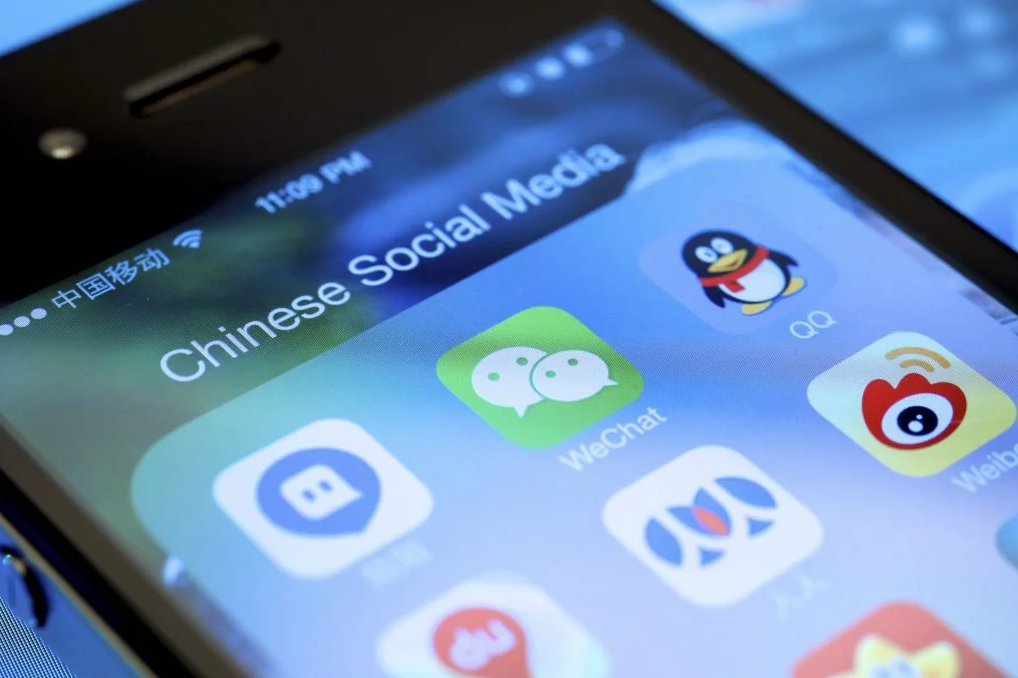Nowadays, Chinese social media such as Weibo, Douyin, and Xiaohongshu play an increasingly important role in brand marketing. This is due to the fact that Chinese social media has the most extensive and active users in history and has an active 24/7 time cycle. Merchants can use Chinese social media to directly communicate with consumers and continuously obtain users’ feedback on brands. The wave of overseas companies wanting to set up business in China is endless. In China’s market full of opportunities, many overseas companies have tasted success, but the challenges are also constant. What kind of "Chinese social media insight" do overseas companies need to learn if they want to achieve long-term development in China?
How Chinese social media affects brands
The importance of Chinese social media for brands
User cultivation
A huge driver of the popularity of Chinese social media marketing is the customer’s desire to interact genuinely. Brands felt alienated and detached before the advent of social media, which had the ability to connect people like no other platform could and also facilitate communication and interaction between them. Brands can participate in social media trends, and chat with customers in real-time.
Brand cultivation
Through social media, brands can directly reach many people. Connecting with more and more people shows that brands will achieve a considerable word-of-mouth spread. Social media provides enormous opportunities for brands to grow their business through marketing strategies. After a certain period of time and proper customer cultivation, the seed eventually becomes a big tree. “Word-of-mouth” is contagious, so nothing help promotes a brand image better than “customer sharing.”
Channel cultivation
Without huge amounts of investment, brands can build their own businesses online through social media. All a business needs is a good idea and action. There are countless domestic and overseas businesses in China that use Weibo or Douyin to sell products and promote services. Through the ability of platform interaction and sales growth, brands can undoubtedly surpass their competitors. Click to learn how to build more about sales channel.
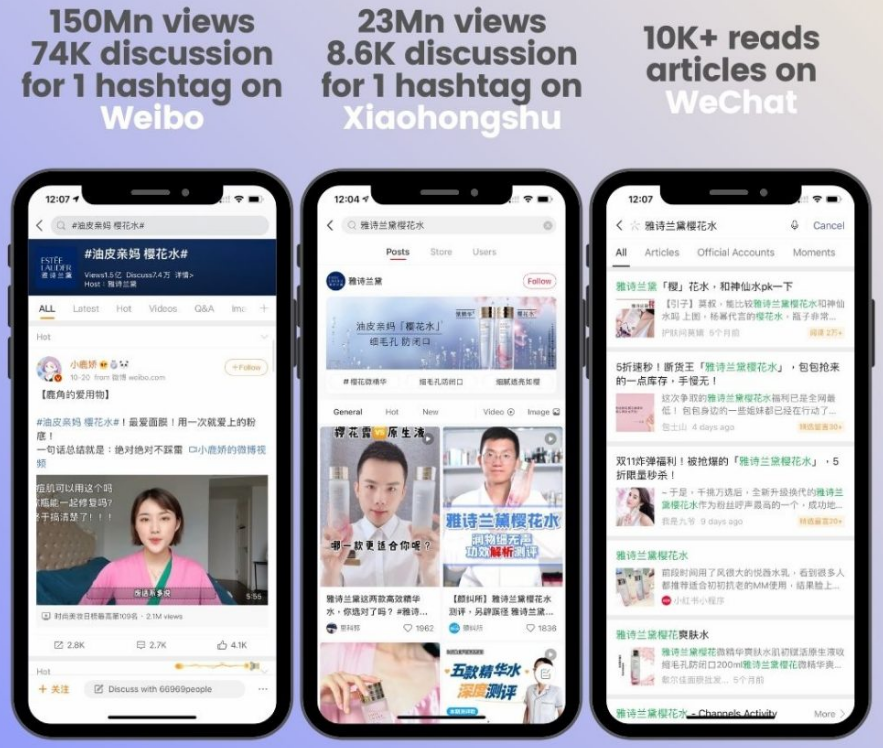
Benefits of social media marketing for brands
Quickly build brand reputation
Social media in China such as Weibo and Douyin own more than a billion users who are potential customers for brands. A brand can be built quickly with a relatively small budget compared to expensive traditional media.
Accurately target customers
Social media in China such as Weibo, Douyin, and Xiaohongshu can provide brands with unexpected precision marketing. These social media know their customers better than any other platforms—both online and offline.
Attract potential customers
Social media marketing can help brands broaden traffic entrances and attract potential customers. If you only promote on a certain platform, only a certain group of people may know your brands, but through the characteristics of social media marketing, you can do marketing and promotion to almost all Chinese people and attract potential buyers worldwide.
Use Chinese social media to serve customers
There are tens of millions of merchants selling the same product in China’s market, so buyers have thousands of choices. If you want to retain these customers, you should interact with them more frequently anytime and anywhere.
Click to know more about Marketing advice for China’s ecommerce 2023.
Differences of Social Media between Chinese and Western
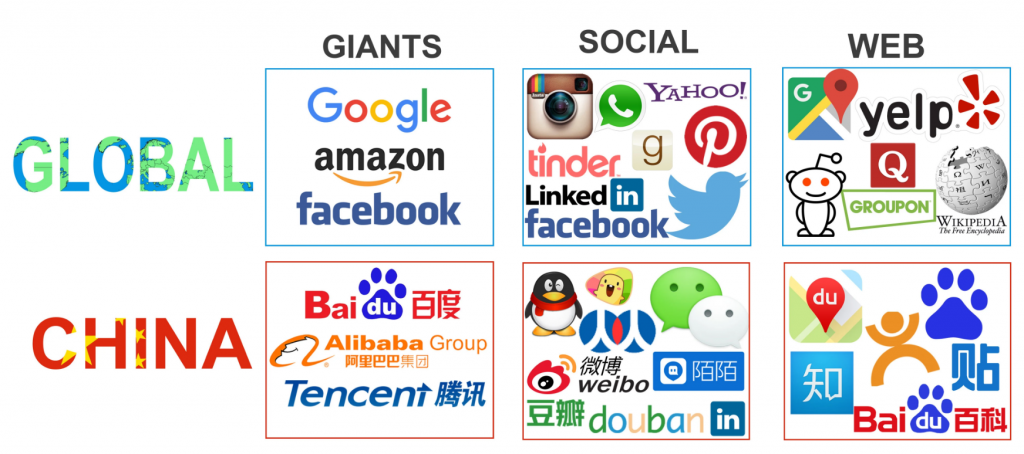
After these years of development, Chinese social media is no longer like the past, where there was always one-to-one correspondence with foreign social media. Therefore, making a comparable infographic that captures the evolution of each platform is extremely challenging. And what makes it even harder is that there is no rigorous scientific basis for this to follow.
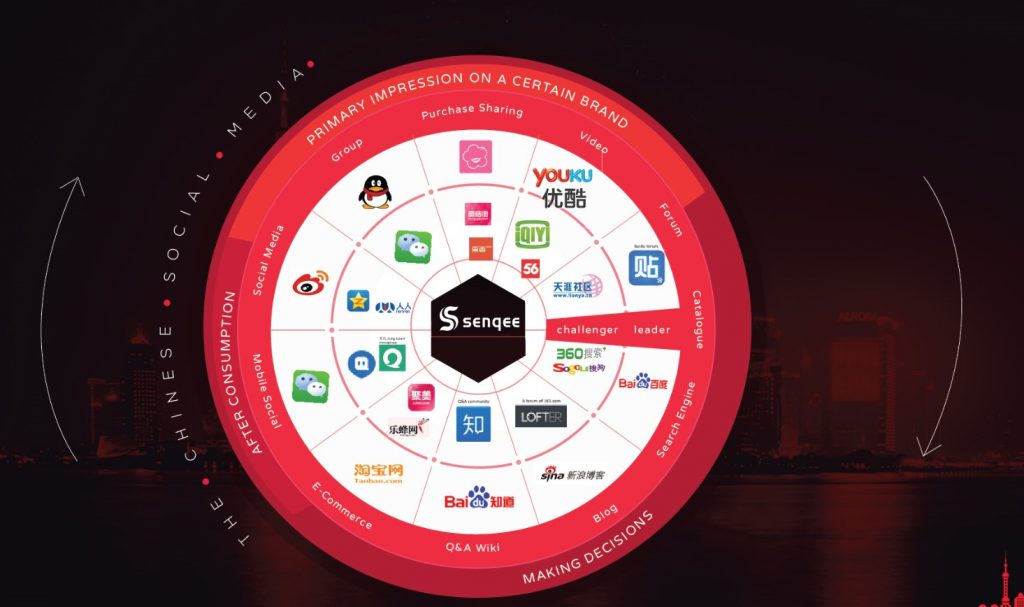
This infographic points out that a good Chinese social media app should always put the user first. In short, it is users who decide what kind of Chinese social media a brand needs to operate. Also, brands should focus on what views and content can excite the audience.
When it comes to the differences between global and Chinese social media, a classic example is LinkedIn. LinkedIn spans overseas and Chinese markets: it is one of the few foreign professional social platforms that can successfully enter the Chinese market. But in China, social networking is largely built on face-to-face interactions, so it’s a major cultural hurdle for LinkedIn. As it continues to launch products that are more relevant to China, LinkedIn will surely create more opportunities for Chinese local brands.
The differences between Chinese and foreign social media also lie in people’s different focuses. Compared with foreign users, Chinese users do not like to follow brands but prefer to follow social accounts set up by individuals, celebrities and media. Apparently, followers of celebrities on Weibo are much more than followers of brands.

If brands want to operate social media well, their owners need to abandon the idea of “owning” a place on social platforms. Brand owners need to pay more attention to celebrities or media who are extremely popular on social media platforms, and find ways to make them actively talk about or create topics about their brands.
There are also differences in the way foreign and Chinese celebrities advertise on social media. Many foreign countries stipulate that if a celebrity advertises, it must be marked as an advertisement, but Chinese celebrities do not need to be specially marked when advertising.
How to turn the interaction on social media into brand private traffic
In fact, the traffic that relies on social media platforms cannot be called private traffic, thus so many brands have been confused by the way of converting social media fans into private traffic.
Focus on short video marketing content
The role of content marketing is never out of date. Attracting users from social media with excellent content, turning genuinely interested passersby into fans, and forming your own private traffic is something worth persisting for a long time. After some brands settle in Douyin, they will produce and publish content on a daily basis. Then the audience who feel interested will watch and become fans of the brands. When the brands start live streaming, these fans will naturally come in and watch. At the same time, some brands will get extra traffic during the live streaming. If the audience is interested, they will also become followers of brands and help the account gradually accumulate private traffic.
Get traffic from celebrities
In the era of traditional advertising, celebrity endorsement is a conventional marketing method. But, In fact, it is quite difficult for brands to turn celebrity fans into brands’ followers. However, it is becoming more possible in the age of social media. For example, VIP invited Joker Xue and Deng Ziqi to live broadcast during the 618 promotion. The live broadcast achieved sales growth by mobilizing the energy of star fans: Among them, Joker Xue fans contributed 50% of the shopping cart clicks. And Deng Ziqi’s live broadcast has enabled VIP’s brand account to accumulate 120,000+ fans. The fast and visible characteristics of live broadcasts make it easier for brands to convert fans of celebrities into their own fans. However, it does not mean that turning fans of stars into your fans is private traffic, brands must continue to operate well in order to make those followers become a group with loyalty, become “real” fans.

Accurate advertising on social media
Nowadays, precise advertising is still required for brands to obtain targeted private traffic. With the help of data calculation and placement, brands can find relatively precise users and attract them to become customers. Paid accurate advertising is a relatively quick way to test the effectiveness of the traffic you buy. If the traffic you buy has been optimized, then the expected effect can be achieved, such as a visible increase in sales while ROI is maintained, so this kind of marketing is sustainable.
Chinese social media usage
Mobile netizens account for the vast majority of China’s netizens, and mobile netizens overlap with social media netizens. Accordingly, the table below regards the respondent’s mobile phone surfing status as the overall application of social media.
Time spent on social media per capita in China
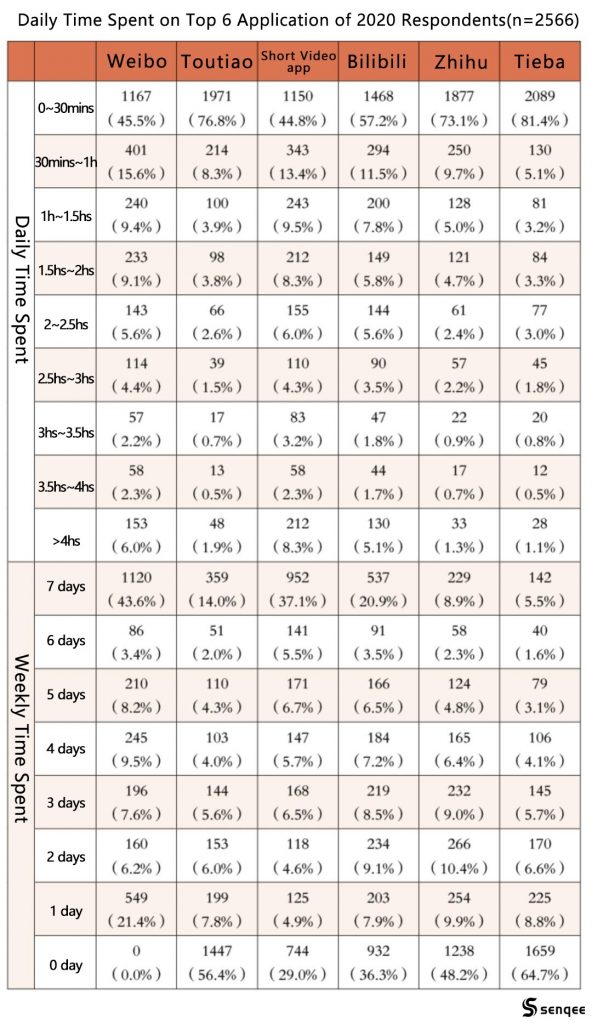
It can be inferred from the table that the respondents show obvious differences in the application of different mainstream Chinese social media. The use of Weibo shows the behavior characteristics of high frequency and low duration; Toutiao-like apps show a trend of polarization, more than half of the people (56.4%) have not been exposed to this app, and the proportion of respondents who use it daily is 14%; social short video applications also show polarization. The proportion of daily contact with short video is 37.1%, and the proportion of non-contact is 29%; The proportion of non-contact Bilibili is 36.3%, which is significantly higher than that of daily contact. (20.9%); the application prospects of Zhihu and Tieba are relatively uncertain. As the traditional forms of social media, corresponding adjustments are urgently needed to maintain the market size.
10 Well-known Chinese Social Media Apps
Narrowing down top Chinese social media apps is no easy work. There are tons of apps that cater to very specific users, so when brands don’t know what social media platform to choose to operate on, the short list of Chinese social media apps can come in handy.
Here is a list of the most popular Chinese social media apps:
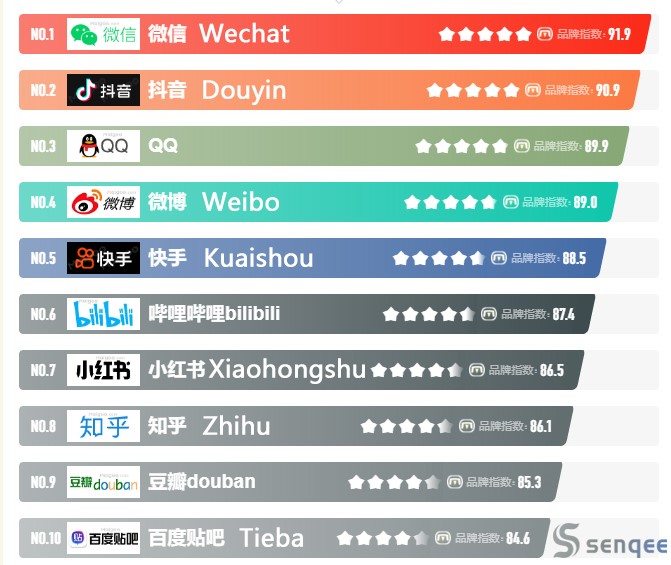
WeChat, a Chinese instant messaging app developed by Tencent, is containing the function of social media and also mobile payment. It was released in 2011 and became the world’s largest standalone mobile application in 2018, with over 1 billion monthly active users. WeChat has been described as China’s “all-in-one app” or a super-app because of its wide range of functions. WeChat provides text messaging, hold-to-talk voice messaging, broadcast (one-to-many) messaging, daily payment, video conferencing, mini-program, video games, sharing of photographs and videos and location sharing and so on.
Douyin (aka Chinese TikTok)
Launched in 2016, Douyin is a short video social media app incubated by ByteDance. It is a short video community platform suitable for all ages. Users can use the app to capture videos and form their own works. With the brand slogan of “recording a good life”, users can find practical content covering life, food, travel, shopping, technology and news.
Tencent QQ
Tencent QQ also known as QQ, is an instant messaging application and web portal developed by Tencent. QQ offers services that provide microblogging, online social games, music, shopping, movies, and group and voice chat application. As of March 2022, QQ has 563.8 million active accounts of QQ monthly.
Launched by Sina Corporation in 2009, Sina Weibo is a Chinese microblogging application and website. It is one of the biggest social media platforms in China, owning over 582 million active users per month and 252 million daily active users as of Q1 2022.
Weibo is a social media platform based on user relationships. Users access it through various terminals, such as PCs and mobile phones, and realize instant sharing, dissemination and interaction of information in multimedia forms such as text, pictures, and videos.
The platform has reached a huge financial success, with surging stocks, lucrative advertising sales and high revenue and total earnings per quarter. At the start of 2018, it surpassed the US$30 billion market valuation mark for the first time.
Kuaishou
Kuaishou (‘Quick hand’) is a short video-sharing application with a unique video special effects editor, launched in 2011 by Beijing Kuaishou Technology. As of 2019, Kuaishou has a worldwide user base of over 200 million, leading the “Most Downloaded” lists of the Apple App Store and Google Play in eight countries, such as Brazil. In Indonesia and Pakistan, Kuaishou is known as Snack Video. Its major competitor is Douyin. Compared with Douyin, Kuaishou’s short video content is more local and younger.
Bilibili
Bilibili, also known as B Site, is a video-sharing website and application based in Shanghai where users can submit, view and add overlaid commentary on videos. Since the mid-2010s, Bilibili began to expand to a broader audience from its original niche market that focused on anime, comics, and games (ACG), and it has become one of the major Chinese over-the-top streaming platforms serving videos on demand, such as documentaries, variety shows, and other original programming.
Bilibili hosts videos on various themes, including anime, music, dance, science and technology, movies, drama, fashion and video games, but it is also known for its extensive kuso-style parodies by subcultural content creators. Bilibili provides a live streaming service where the audience can interact with streamers. Bilibili also offers games, mostly ACG-themed mobile games, such as the Chinese version of Fate/Grand Order.
Little Red Book (aka Xiaohongshu, or RED)
Xiaohongshu, a Chinese social media and e-commerce platform, has been described as “China’s answer to Pinterest or Instagram”.
As of 2019, Xiaohongshu had 300 million registered users and 85 million monthly active users. Reportedly 70% of its users are born after the Z generation, and nearly 90% of them are females. The application allows users and influencers to post, discover and share daily life, most frequently related to beauty and health. Travel bloggers are known to regularly post high-quality content regarding tourism and leisure destinations on Xiaohongshu. Xiaohongshu also operates RED Mall, which sells international products to Chinese users.
Xiaohongshu’s headquarters are in Huangpu District, Shanghai.
Zhihu
Zhihu, launched on January 26, 2011, is a website and application where questions are created, edited, answered and organized by the community of its users. Zhihu’s registered users had exceeded 220 million by the end of 2018. It has accumulated more than 30 million questions and 130 million answers.
Douban
Douban.com launched on 6 March 2005, is a Chinese online database. It allows registered users to create content related and record information, books, music, recent events, and activities in Chinese cities.
Douban was opened to both registered and unregistered users. For registered users, the website recommends potentially interesting books, movies, and music to them in addition to serving as a social network website such as WeChat, Weibo and record keeper. For unregistered users, the website is a place to find ratings and reviews of media.
Douban has over 200 million registered users as of 2013 and some Chinese authors as well as critics register their official personal pages on the site. Douban has been compared to other review sites such as IMDb, Rotten Tomatoes and Goodreads.
Baidu Tieba
Baidu Tieba uses forums called bars as a place for users to socially interact. The slogan of Baidu Tieba is “Born for your interest”. As of 2014, there were more than eight million bars, mostly created by fans, which covered a variety of topics, such as celebrities, films, comics, and books. More than one billion posts have been published in these bars. Baidu Tieba has accumulated 45 million monthly active users as of December 2021, and the number of its registered users reached 1.5 billion.
Trends of Chinese Social Media You Must Know in 2023
Because of the epidemic, the influence of social media is still increasing. It is not just a communication medium. Online marketing has gradually become mainstream. For products, promotion is crucial to them. The frequency of posting by many brands is also increasing, creating good content to continuously increase exposure, and actively interacting with users on social media, so that fans will strengthen their trust in the brand.
So, what will Chinese social media trends look like in 2023?
High-Quality Content
In recent years, low-frequency and high-quality content has gradually replaced frequently released low-quality content and has become the choice of brands on social media platforms. Especially the interactive content of the brand, the real story behind the brand, and the content that reflects the brand value. These high-quality and well-created contents can make visitors who have never known the brand spontaneously become fans of the promoted brand, and continuous content creation will increase the loyalty and interaction rate of fans.
KOL Marketing
The development trend of social media points out that people tend to believe the words or experiences shared by influencers or celebrities they follow, and KOL can have a strong influence on the followers’ purchasing decisions. More and more advertisers are willing to adopt KOL marketing strategies to enable them to reach specific customers at a relatively low cost while stimulating discussion and sharing positive feedback. MCN agencies also help to maximize revenue-generating impact and the overall development of social media advertising. They promote closer cooperation among advertisers, KOLs and social media platforms.

Innovation of solutions
More innovative advertising and marketing services will emerge in the future, especially in the field of content marketing or KOL marketing. Chinese social media platforms provide a series of diversified advertising and marketing solutions that apply big data and artificial intelligence technologies, enabling advertisers to directly and effectively interact with target users. At the same time, social media platforms are actively building an ecosystem to empower celebrities, stars, MCN agencies and KOLs for marketing, such as providing content generation tools, user interaction functions and a variety of advertisers and commercial resource options.
How can brands make the most of social media
Multi-channel operation
As mentioned above, there are all kinds of social media platforms. Before your brand enters the market of China, you should do corresponding market research, select several social media platforms suitable for your brand, and then operate in multiple channels, so as to speed up the integration of social media and brands and strengthen brand influence.
Cooperate with brand sales channels to operate social media
There are advantages and disadvantages to diverting traffic to private traffic through operating social media. The disadvantage is that the cost is higher, and the advantage is that customer loyalty is higher, and it is suitable for long-term development. If the brand has a certain reputation and customers, it is more suitable to operate social media and cooperate with Tmall or JD stores.
Strengthen the cooperation between brands and influencers
Partner with brand-appropriate influencers to promote your brand and products, relying on creators and influencers to provide advertising creatives. Celebrities have their own characteristics and content creation mode, which can break the original shackles of the brand and provide users with a better viewing experience.

These ideas are also faster, cheaper, and easier to produce. You can also invite celebrities to live broadcasts for your brand. The live broadcast will give consumers a more intimate feeling, make the brand more humanized, and interact with users at any time, making the relationship with users closer.
Conclusion
Compared with traditional marketing mode, Chinese social media is closer to users. It has changed the original one-way indoctrination of information transmission mode and made communication more efficient and diversified. Chinese social media is an integral part of brand development. If you’re not using social media to build your brand, you’re missing out on one of the best ways to connect with your customers.

In fact, social media can help you build your brand in many ways. Brand building is inseparable from users, so the brand must adapt to changes, grasp the changes, and make full use of Chinese social media to serve the brand, so as not to be abandoned by users, surpassed by competitors, and eliminated by the market.
